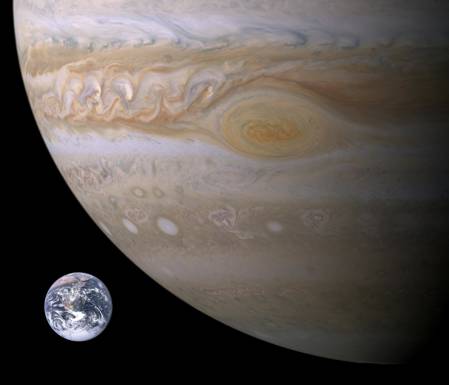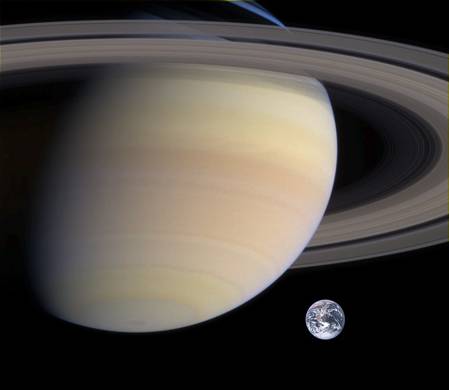What’s So Special about Jupiter and Saturn?
It was 1980. I was scheduled to speak in what was then an extremely violent part of Soweto, South Africa. Five burly men joined me in a car ride to the event; I sat in the middle of the back seat and was instructed by my companions to “keep my head down.” The reasoning was that if any bullets or other projectiles penetrated the car my companions would absorb the damage and thereby keep me safe.
Jupiter and Saturn offer the same kind of protection for Earth. Because Jupiter and Saturn are so large and massive compared to Earth (see figures 1 and 2), they shield Earth from would-be attackers (in this case, asteroid and comet collisions) by scattering incoming objects gravitationally or by absorbing collisions themselves.

Even a single storm eddy (the Great Red Spot) on Jupiter is larger in size than planet Earth.
Image credits: NASA

The width of Saturn’s middle rings is greater than Earth’s diameter.
Image credits: NASA
Astronomers now realize it is not just the size and mass of both Jupiter and Saturn that work together to protect Earth—it is also the dimensions and characteristics of these gas giants’ respective orbits. If these two planets orbited any closer to Earth or manifested orbits any more eccentric (elliptical), their gravity would so disturb Earth’s own orbit so as to make it unfit for the support of advanced life. On the other hand, if they were more distant or their masses any smaller, they would not protect Earth adequately.
Two Chinese astronomers at Nanjing University, Hui Zhang and Ji-Lin Zhou, set out to model Jupiter-Saturn configurations. Specifically, they investigated the orbital evolution of two gas giant planets with masses analogous to those of Jupiter and Saturn in a gaseous disk surrounding its host star.
In their first paper, Zhang and Zhou considered the case where the Jupiter analogue orbited its host star interior to the orbit of the Saturn analogue,1 just like Jupiter does in our solar system. They found that tidal perturbations of the Jupiter analogue generated either an inward or an outward runaway migration of the Saturn analogue. That is, either the Saturn analogue was sent hurtling in toward the host star or it was flung out into the far outer reaches of the planetary system.
The only exceptions to these runaway migration scenarios were those where the Saturn analogue was trapped into either a 2:1 or 3:2 mean motion resonance. These resonances are situations where the Jupiter analogue completes either two orbits for every single orbit of the Saturn analogue or three orbits for every two orbits of the Saturn analogue. Both circumstances would disrupt the orbits of smaller planets existing in the same planetary system.
In their second paper, Zhang and Zhou analyzed the reverse configuration, where the Saturn analogue orbited its host star interior to the Jupiter analogue.2 They found that where the initial separation of the two planets is relatively large, the two planets undergo divergent migration. Depending on the properties of the gaseous disk, (1) the Jupiter analogue migrates outward while the Saturn analogue rapidly migrates inward; or (2) both planets migrate inward, with the Saturn analogue migrating at a much faster rate. Either way, the most likely outcome of the Saturn analogue is that it ends up with a close-in, high-eccentricity orbit of the host star.
Zhang and Zhou’s second paper goes a long way toward explaining why so many of the 490 known extrasolar planets are “hot-Jupiters” or “hot-Saturns” with high-eccentricity orbits. Their two papers also help explain why astronomers so far have failed to find a planet that matches both the physical and orbital characteristics of either Jupiter or Saturn.
How is it, then, that Jupiter and Saturn attained all the characteristics that permit the existence of advanced life on Earth? As I reported in our booklet 10 Breakthroughs of 2009, thanks to a just-right combination of supernovae exploding at just-right locations and times relative to the emerging solar system, the primordial solar system was bombarded with aluminum-26 isotopes.3 These isotopes so irradiated the early solar system as to drive off the gas disk and deplete the emerging planets of much of their methane, water, carbon monoxide, and carbon dioxide.4 In combination with the existence of two fine-tuned smaller gas giant planets (Uranus and Neptune) and three fine-tuned comet/asteroid belts (main belt, Kuiper belt, and Oort cloud), this fine-tuned gas depletion paved the way for the formation of the Sun’s planetary system such that one of those planets can sustain advanced life.
By itself, Zhang and Zhou’s analysis did not solve the problem of how Jupiter and Saturn ended up with the just-right features to permit the existence of advanced life on Earth. Their research, however, did add to the weight of evidence for the rare-Earth and rare-solar system doctrines. These doctrines state that planets the size and mass of Earth may prove abundant, but planets with just-right characteristics, physical and chemical composition, and planetary partners to enable the support of advanced life will prove either rare or nonexistent. Such doctrines are consistent with the Bible’s message that God supernaturally designed Earth, its planetary partners, and its life for the specific benefit of human beings.
Endnotes
- Hui Zhang and Ji-Lin Zhou, “On the Orbital Evolution of Giant Planet Pair Embedded in a Gaseous Disk. I. Jupiter-Saturn Configuration,” Astrophysical Journal 714 (May 1, 2010): 532–48.
- Hui Zhang and Ji-Lin Zhou, “On the Orbital Evolution of a Giant Planet Pair Embedded in a Gaseous Disk. II. A Saturn-Jupiter Configuration,” Astrophysical Journal 719 (August 10, 2010): 671–84,
- Hugh Ross, “Thank God for Aluminum,” in 10 Breakthroughs of 2009: Scientific Discoveries That Affirm Creation, ed. Joe Aguirre (Glendora, CA: Reasons to Believe, 2009): 25–26.
- J. D. Gilmour and C. A. Middleton, “Anthropic Selection of a Solar System with a High 26Al/27Al Ratio: Implications and a Possible Mechanism,” Icarus 201 (June 2009): 821–23.




